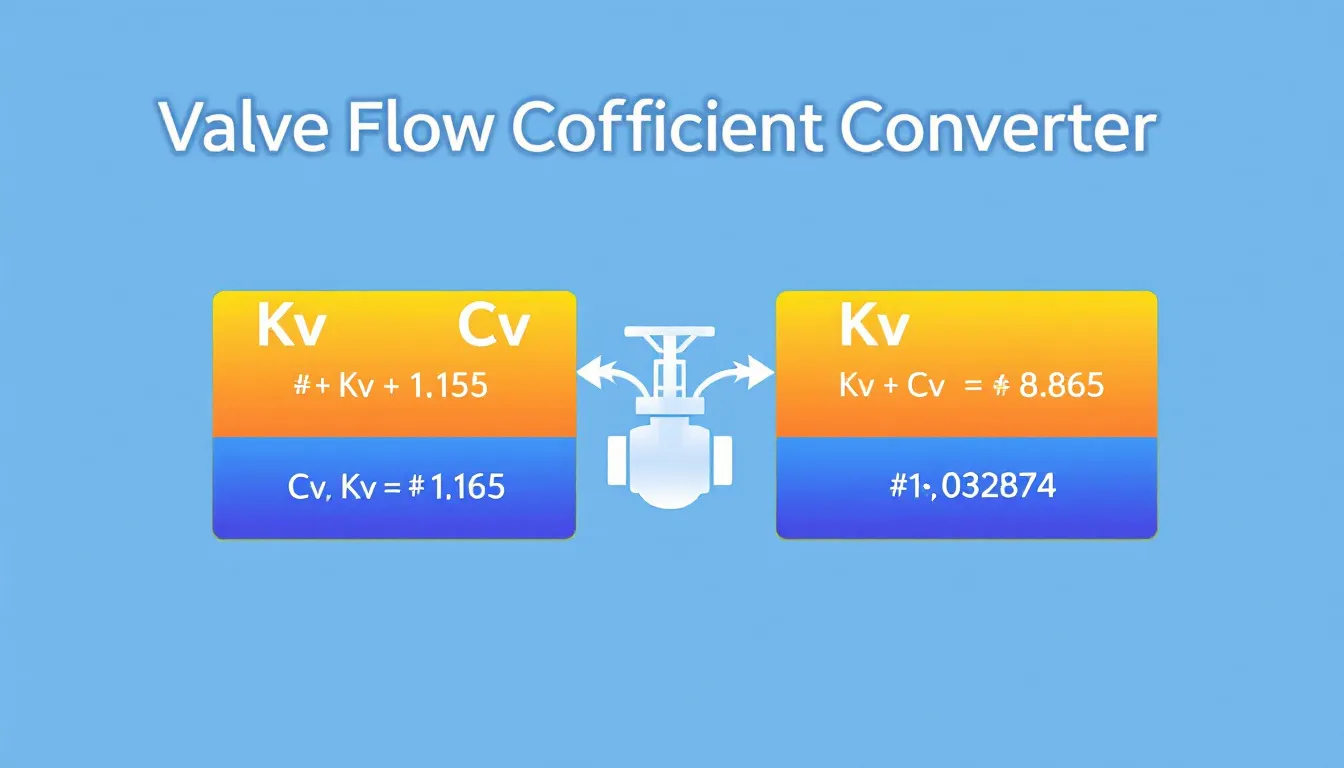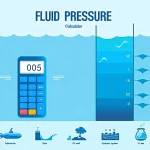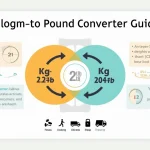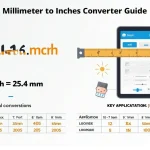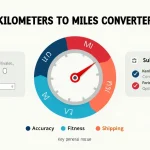Valve Flow Coefficient Converter
Is this tool helpful?
How to Use the Valve Flow Coefficient Converter Effectively
The Valve Flow Coefficient Converter is a user-friendly tool designed to help engineers, technicians, and fluid dynamics professionals easily convert between Kv and Cv values. Here’s a step-by-step guide on how to use this calculator effectively:
- Select the Conversion Type: Choose between “Kv to Cv” or “Cv to Kv” from the dropdown menu. This selection determines the direction of your conversion.
- Enter the Flow Coefficient Value: Input the known Kv or Cv value in the “Flow Coefficient Value” field. For example, if you’re converting from Kv to Cv, you might enter a Kv value of 85.3. If you’re converting from Cv to Kv, you could enter a Cv value of 132.7.
- Click “Convert”: After entering the value, simply click the “Convert” button to perform the calculation.
- View the Result: The converted value will be displayed below the form, showing either the calculated Cv or Kv value, depending on your initial selection.
Remember, the calculator assumes standard conditions for water. For more complex scenarios involving different fluids or non-standard conditions, additional calculations may be necessary.
Understanding Valve Flow Coefficients: Kv and Cv
Valve flow coefficients are essential parameters in fluid dynamics and process engineering, used to characterize the flow capacity of valves under specific conditions. The two primary coefficients used in the industry are Kv and Cv, which represent the same property but in different unit systems.
What is Kv?
Kv, or the metric flow coefficient, is defined as the volume flow rate of water in cubic meters per hour (m³/h) that passes through a valve with a pressure drop of 1 bar at a specified reference temperature (usually 15°C or 20°C).
What is Cv?
Cv, or the imperial flow coefficient, is defined as the volume flow rate of water in US gallons per minute (GPM) that passes through a valve with a pressure drop of 1 psi at 60°F (15.6°C).
The Importance of Kv and Cv Conversion
Converting between Kv and Cv is crucial for several reasons:
- International standardization: As projects and equipment often cross borders, the ability to convert between metric and imperial units is essential.
- Valve selection: When choosing valves from different manufacturers or regions, easy conversion ensures accurate comparisons.
- System design: Engineers working on international projects need to seamlessly integrate components specified in different unit systems.
- Retrofitting: When updating older systems or replacing components, conversion between Kv and Cv helps maintain system integrity.
The Mathematics Behind Kv and Cv Conversion
Understanding the mathematical relationship between Kv and Cv is crucial for accurate conversions. The formulas for converting between these flow coefficients are based on the relationship between their respective units and reference conditions.
Conversion Formulas
To convert from Kv to Cv:
$$Cv = Kv \times 1.156$$To convert from Cv to Kv:
$$Kv = Cv \times 0.865$$Derivation of Conversion Factors
The conversion factors (1.156 and 0.865) are derived from the relationships between the units used in defining Kv and Cv. Here’s a breakdown of the derivation:
- Flow Rate Conversion: 1 m³/h = 4.403 GPM
- Pressure Drop Conversion: 1 bar = 14.5038 psi
- Derivation of Cv from Kv: $$Cv = Kv \times \frac{Q_{GPM}}{Q_{m³/h}} \times \sqrt{\frac{\Delta P_{bar}}{\Delta P_{psi}}}$$ $$Cv = Kv \times 4.403 \times \sqrt{\frac{1}{14.5038}}$$ $$Cv = Kv \times 1.156$$
- Derivation of Kv from Cv: $$Kv = Cv \times \frac{Q_{m³/h}}{Q_{GPM}} \times \sqrt{\frac{\Delta P_{psi}}{\Delta P_{bar}}}$$ $$Kv = Cv \times 0.865$$
Benefits of Using the Valve Flow Coefficient Converter
The Valve Flow Coefficient Converter offers numerous advantages for professionals working in fluid dynamics, process engineering, and valve selection:
1. Time Savings
Manual calculations can be time-consuming and prone to errors. This tool provides instant, accurate conversions, allowing engineers to focus on more critical aspects of their projects.
2. Improved Accuracy
By eliminating manual calculation errors, the converter ensures precise conversions between Kv and Cv values, leading to more accurate valve sizing and system designs.
3. Enhanced Productivity
With quick and reliable conversions at their fingertips, professionals can work more efficiently, especially when dealing with multiple valves or complex systems.
4. Global Compatibility
The tool bridges the gap between metric and imperial systems, facilitating seamless collaboration on international projects and enabling easy comparison of valves from different manufacturers worldwide.
5. Consistency in Calculations
By using a standardized conversion tool, teams can ensure consistency in their calculations, reducing discrepancies that might arise from using different conversion methods or factors.
6. Educational Value
For students and newcomers to the field, the converter serves as an educational tool, helping them understand the relationship between Kv and Cv and reinforcing the importance of unit conversions in engineering.
Addressing User Needs and Solving Specific Problems
The Valve Flow Coefficient Converter addresses several key challenges faced by professionals in the fluid dynamics and process engineering fields:
1. International Project Coordination
Problem: Engineers working on international projects often encounter specifications in both metric and imperial units.
Solution: The converter allows quick translation between Kv and Cv values, enabling seamless integration of components from different regions.
2. Valve Selection and Comparison
Problem: Comparing valves from different manufacturers can be challenging when flow coefficients are provided in different units.
Solution: By converting all values to a common unit (either Kv or Cv), engineers can easily compare and select the most suitable valves for their applications.
3. System Retrofits and Upgrades
Problem: When upgrading older systems, engineers may need to replace valves specified in one unit system with those using another.
Solution: The converter facilitates easy matching of new valves to existing system requirements, ensuring compatibility and maintaining system performance.
4. Regulatory Compliance
Problem: Different regions may have regulations specifying valve coefficients in either Kv or Cv.
Solution: The tool allows quick conversion to comply with local regulations while maintaining consistency with original design specifications.
5. Documentation and Reporting
Problem: Preparing reports and documentation for international clients or multi-regional projects can be complex when dealing with different unit systems.
Solution: The converter enables easy standardization of valve specifications in reports, ensuring clarity and reducing the potential for misinterpretation.
Practical Applications and Use Cases
The Valve Flow Coefficient Converter finds application in various scenarios across different industries. Here are some practical use cases:
1. Oil and Gas Industry
An engineer working on an offshore platform needs to replace a control valve. The original valve specification is in Cv (120), but the replacement options are listed with Kv values. Using the converter, the engineer calculates the equivalent Kv (103.8) and selects the appropriate replacement valve.
2. Water Treatment Plants
A water treatment facility is expanding and needs to integrate new equipment from a European manufacturer (specified in Kv) with existing American-made systems (specified in Cv). The converter allows engineers to easily translate between the two systems, ensuring proper sizing and integration.
3. Chemical Processing
A chemical plant is optimizing its process flow. The engineer needs to compare the performance of various control valves, some specified in Kv and others in Cv. By converting all values to a common unit (e.g., Cv), the engineer can make accurate comparisons and select the most efficient valves for each process stage.
4. HVAC Systems
An HVAC designer is working on a large international project with components sourced from multiple countries. By using the converter, they can ensure that all valves in the system are properly sized and matched, regardless of whether they were originally specified in Kv or Cv.
5. Pharmaceutical Manufacturing
A pharmaceutical company is scaling up production and needs to resize valves in their process. The original small-scale system used valves specified in Cv, but the new larger valves are listed with Kv values. The converter allows engineers to accurately scale up the valve sizes while maintaining the correct flow characteristics.
6. Aerospace Industry
An aerospace engineer is designing a fuel system for a new aircraft. Components are sourced from global suppliers, with valve specifications in both Kv and Cv. The converter enables the engineer to standardize all specifications to one unit system, ensuring consistency across the entire fuel system design.
Frequently Asked Questions (FAQ)
Q1: What is the difference between Kv and Cv?
A1: Kv and Cv are both valve flow coefficients, but they use different unit systems. Kv is the metric flow coefficient measured in m³/h, while Cv is the imperial flow coefficient measured in GPM. They represent the same property but are used in different regions and industries.
Q2: Can I use this converter for fluids other than water?
A2: The basic Kv to Cv conversion is based on water at standard conditions. For other fluids or non-standard conditions, additional factors such as specific gravity and viscosity may need to be considered for accurate valve sizing.
Q3: How often should I convert between Kv and Cv?
A3: Conversion between Kv and Cv is necessary whenever you’re working with valves or systems that use different unit standards. This is common in international projects, when comparing products from different manufacturers, or when integrating new components into existing systems.
Q4: Are there any industry standards for using Kv or Cv?
A4: Generally, Kv is more commonly used in Europe and metric system countries, while Cv is prevalent in the United States and countries using imperial units. However, many international standards recognize both coefficients.
Q5: Can this converter be used for all types of valves?
A5: Yes, the Kv to Cv conversion is applicable to all types of valves, including control valves, ball valves, gate valves, and globe valves. However, it’s important to note that other factors may influence the overall valve performance in specific applications.
Q6: How does temperature affect Kv and Cv values?
A6: The standard definitions of Kv and Cv are based on specific reference temperatures (usually 15°C or 20°C for Kv, and 60°F for Cv). Significant deviations from these temperatures may require additional corrections for accurate valve sizing.
Q7: Can I use this converter for gas flow applications?
A7: While the basic conversion between Kv and Cv remains the same, gas flow applications typically require additional considerations such as gas density, compressibility, and expansion factors. The converter provides a starting point, but further calculations may be necessary for precise gas flow valve sizing.
Q8: How do Kv and Cv relate to valve sizing?
A8: Kv and Cv are crucial for proper valve sizing. They help determine the flow capacity of a valve under specific pressure conditions. Correct valve sizing ensures optimal system performance, energy efficiency, and control accuracy.
Q9: Is there a simple way to remember the conversion factors?
A9: A simple mnemonic is “CV Larger”: Cv is always larger than Kv for the same valve. To convert Kv to Cv, multiply by ~1.16 (making it larger). To convert Cv to Kv, multiply by ~0.86 (making it smaller).
Q10: How does the converter handle very large or very small values?
A10: The converter is designed to handle a wide range of values, from very small to very large. However, for extremely large or small values, it’s important to consider the practical implications in real-world valve applications and consult with valve manufacturers if necessary.
By addressing these common questions, users can gain a deeper understanding of the Valve Flow Coefficient Converter and its applications in various engineering scenarios. This knowledge enhances the tool’s utility and helps users make more informed decisions in valve selection and system design.
Important Disclaimer
The calculations, results, and content provided by our tools are not guaranteed to be accurate, complete, or reliable. Users are responsible for verifying and interpreting the results. Our content and tools may contain errors, biases, or inconsistencies. We reserve the right to save inputs and outputs from our tools for the purposes of error debugging, bias identification, and performance improvement. External companies providing AI models used in our tools may also save and process data in accordance with their own policies. By using our tools, you consent to this data collection and processing. We reserve the right to limit the usage of our tools based on current usability factors. By using our tools, you acknowledge that you have read, understood, and agreed to this disclaimer. You accept the inherent risks and limitations associated with the use of our tools and services.
